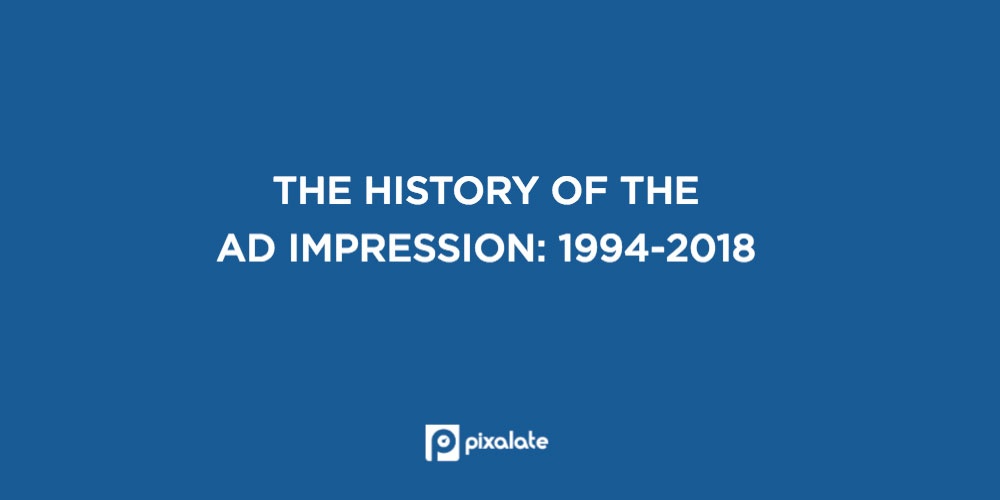In the digital advertising world, ‘impressions’ refer to individual ad transactions — e.g. when a digital publisher sells a space on their site to an advertiser. Digital advertisers and publishers have long relied on impression statistics (CPI, CPM, etc.) to manage campaigns and budgets.
Over the past 20 years, industry standards for recording impressions have gone through a series of changes. Pixalate walks you through the history of impression measurement in the digital advertising landscape, starting with the first online banner ad, sold in 1994.
Want to download this infographic as a PDF? You can do that here.
Notable early moments in history of impression measurement
- October 1994: The first banner ad purchased by AT&T on October 27, 1994. This banner first appeared on hotwired.com
- 1995: Cost Per Mille (CPM) - or cost per 1,000 impressions was first introduced as a pricing model.
- January 1998: The Internet Advertising Bureau (IAB) announced a broad-based industry effort to develop guideline standards for audience measurement of the Internet. This effort included future collaboration with the Media Rating Council (MRC), the American Association of Advertising Agencies (AAAA), and the Mobile Marketing Association (MMA); amongst other industry bodies.
Timeline of major changes to impression measurement standards
- February 2004: The IAB publicly released the Interactive Audience Measurement and Advertising Campaign Reporting and Audit Guidelines, (later revised September 2004, version 6.0b) version 6.0b which established the difference between client-initiated and server-initiated impression counting methodologies and encouraged use of client-initiated (count-on-download) impression measurement methodologies.
- Server-initiated - Uses the site's web content server for making requests, formatting and redirecting content. Server-initiated ad counting methods (the configuration in which impressions are counted at the same time the underlying page content is served).
- Client-initiated - Client-initiated ad counting relies on the user's browser to perform these activities (in this case the term “client” refers to an internet user’s browser or mobile application). Client side measurement involves a recognition on the client side of the successful delivery of an ad impression, and this information is communicated to a counting server for reporting.
- November 2005 - The IAB released the Broadband Video Commercial creative guidelines, their first set of guidelines for broadband video commercials online.
- May 2006 - The IAB (in collaboration with the MRC) released the Broadband Video Commercial Measurement Guidelines. These guidelines later evolved and were later renamed as the Digital Video Ad Impression Measurement Guidelines (revised December 2009). These guidelines qualified video impressions as being recorded at a point, ‘post-buffering’ (later considered to be consistent with the ‘begin to render’ display impression measurement requirements.
- July 2013 - the IAB/MRC/MMA released the Mobile Web Advertising Guidelines (version 2.0) and Mobile Application Advertising Measurement Guidelines (version 1.0 Final Release). These guidelines first introduced additional measurement considerations specific to mobile environments. This guidance also explicitly prohibited the use of server-initiated impression measurement methodologies, only permitting the use of client-initiated impression measurement approaches.
- June 2014 - The MRC (in collaboration with IAB Emerging Innovations Task Force) publicly released the Viewable Ad Impression Measurement Guidelines. These guidelines addressed the industry need for an impression-based metric which took into consideration the opportunity of a user to see the advertising creative. This guidance qualified an ad as ‘viewable’ if at least 50% of its pixels were present on the in-focus browser tab for at least one continuous second (display ads) and two continuous seconds (for video ads).
- October 2017 - MRC/IAB/MMA/MMTF released updated impression-based guidelines formalizing ‘begin to render’ display ad impression measurement criteria across desktop display, mobile web and mobile application (in-app) environments. These guidelines also re-defined impressions recorded prior to the point in which the ad creative had begun to render as tracked ads (e.g., server-side initiated counts or client-side initiated counts recorded prior to the respective ad content beginning to render).



